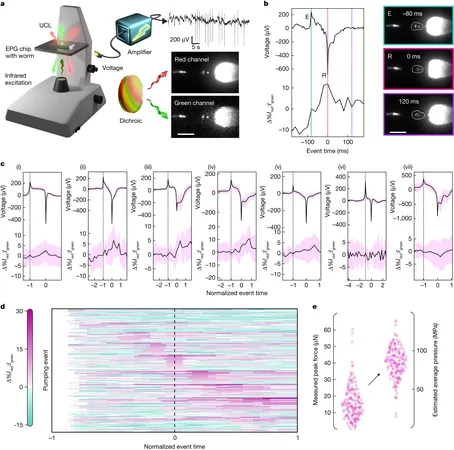
Revolutionary Nanoparticle Technique Unveils Secrets of C. elegans Bite Force—What This Means for Scientific Research!
2025-01-02
Author: Mei
Introduction
In an incredible breakthrough, a collaborative team of researchers from Stanford University has developed a groundbreaking nanoparticle technique capable of quantitatively measuring the bite force of tiny worms known as Caenorhabditis elegans. This innovative study, recently published in the prestigious journal Nature, opens up exciting new avenues for understanding internal biological processes in living organisms.
The Technique
The team, which included experts in materials science, physics, mechanical engineering, and molecular physiology, utilized infrared radiation to excite luminescent nanocrystals embedded in miniature polystyrene spheres. These spheres, roughly the size of bacteria, were cleverly introduced into the worms’ digestive systems, allowing the scientists to analyze the worms' internal muscle dynamics as they processed food.
Significance of the Study
Highlighting the significance of their study, Andries Meijerink from Utrecht University pointed out that measuring forces within living organisms has long been a challenge due to the complexities involved in remote sensing across different scales. With their novel technique, the Stanford team successfully tackled these challenges, enabling them to measure the force generated by the grinder muscle in C. elegans—which operates by tensing and relaxing to crush the worm’s food.
Findings
As the researchers monitored the luminescent nanocrystals inside the worms' grinder muscle using a specialized fluorescence-reading microscope, they were able to capture real-time data on how the force exerted varied during the grinding process. Astonishingly, they discovered that the bite force generated by the C. elegans was approximately 10 micro-Newtons. This measurement not only highlights the complexity of such a simple organism but also opens up doors for deeper insights into muscle physiology.
Implications for Future Research
The implications of this study are profound. Researchers believe that this technique could be a game-changer in biological and medical research, offering a new way to study force dynamics and other critical processes in various living organisms. The ability to conduct remote sensing in living creatures paves the way for further explorations into muscle function, metabolic rates, and possibly even disease mechanisms.
Conclusion
As the world of science continues to push the boundaries of what we know, this remarkable advancement stands as a testament to the power of interdisciplinary collaboration and innovation. Could this nanoparticle method revolutionize our understanding of life at a microscopic level? Only time will tell, but one thing is for certain: the secrets of the tiny C. elegans have just begun to be unveiled!

 Brasil (PT)
Brasil (PT)
 Canada (EN)
Canada (EN)
 Chile (ES)
Chile (ES)
 Česko (CS)
Česko (CS)
 대한민국 (KO)
대한민국 (KO)
 España (ES)
España (ES)
 France (FR)
France (FR)
 Hong Kong (EN)
Hong Kong (EN)
 Italia (IT)
Italia (IT)
 日本 (JA)
日本 (JA)
 Magyarország (HU)
Magyarország (HU)
 Norge (NO)
Norge (NO)
 Polska (PL)
Polska (PL)
 Schweiz (DE)
Schweiz (DE)
 Singapore (EN)
Singapore (EN)
 Sverige (SV)
Sverige (SV)
 Suomi (FI)
Suomi (FI)
 Türkiye (TR)
Türkiye (TR)
 الإمارات العربية المتحدة (AR)
الإمارات العربية المتحدة (AR)